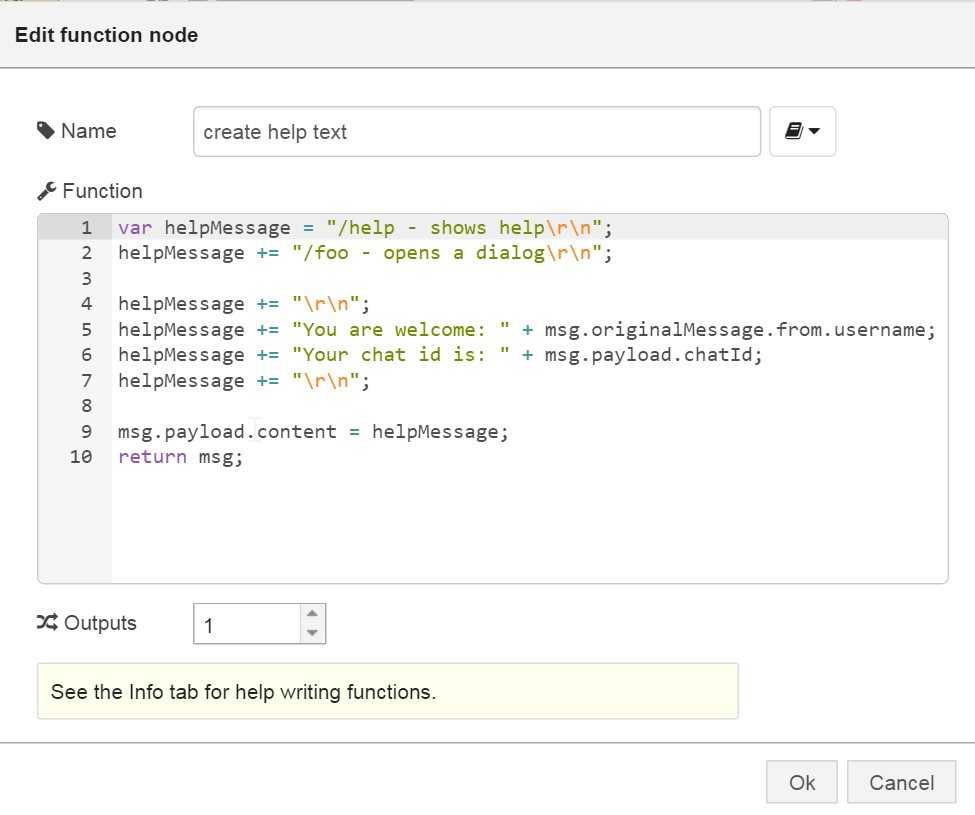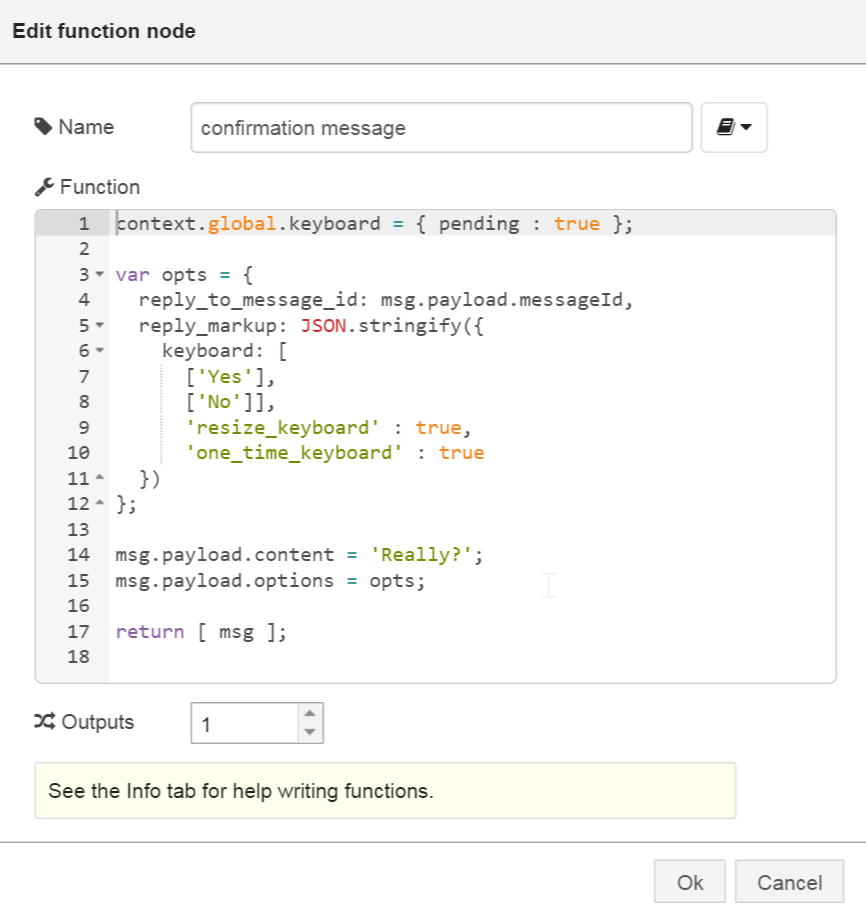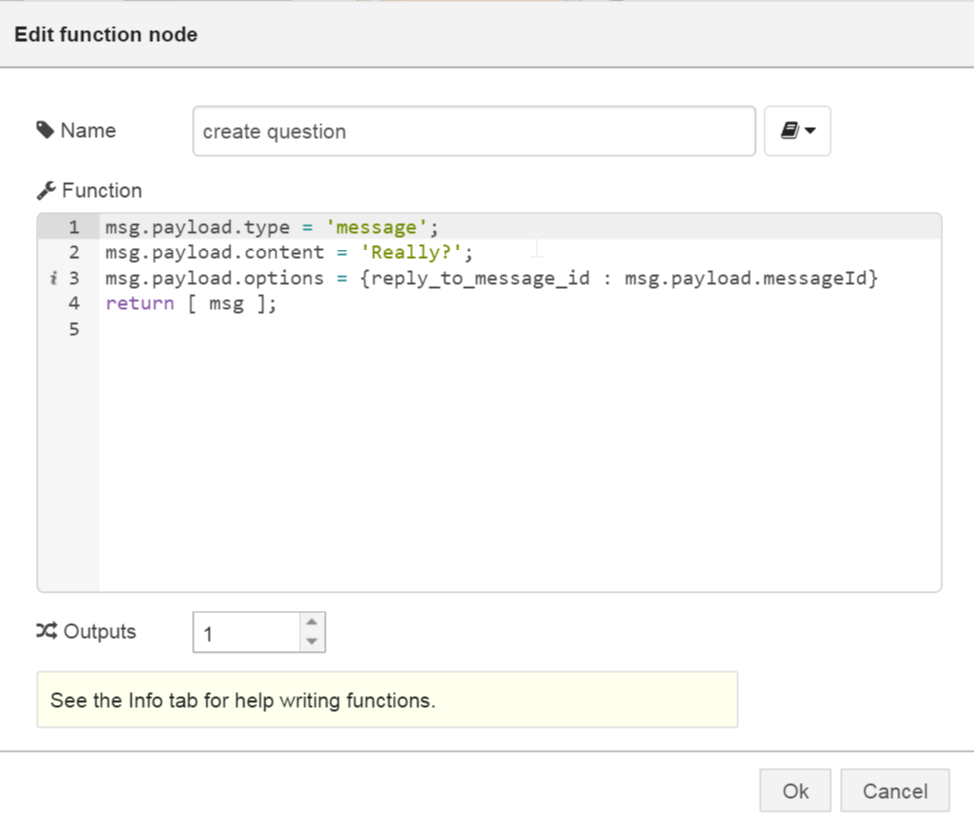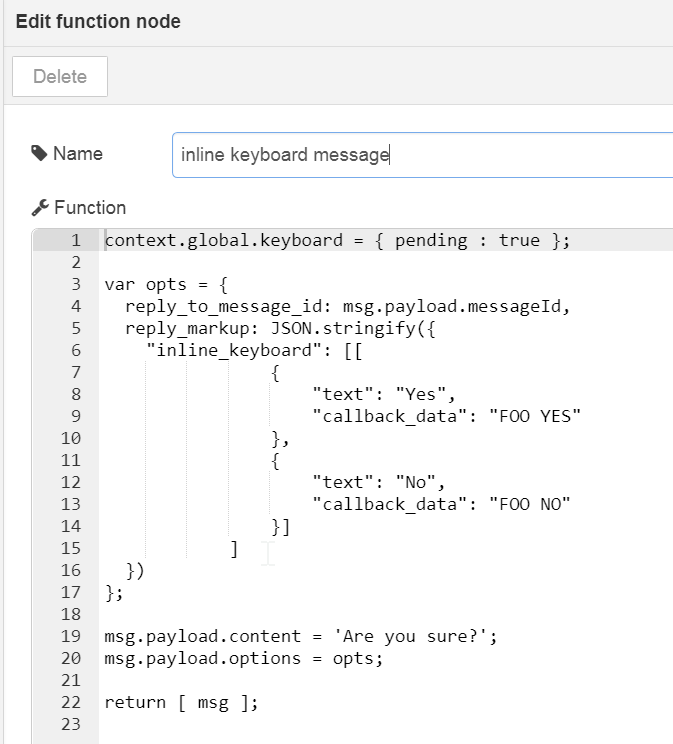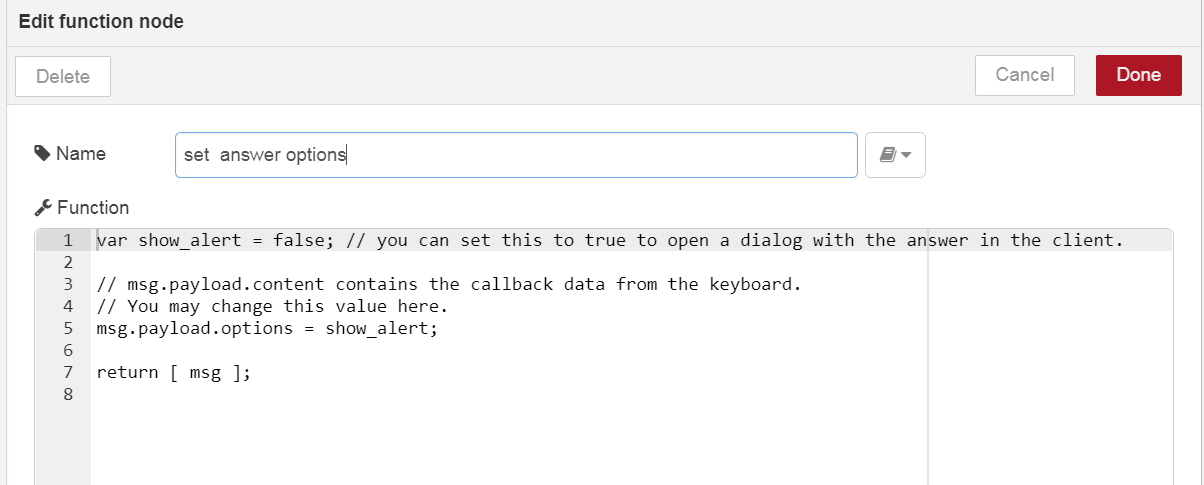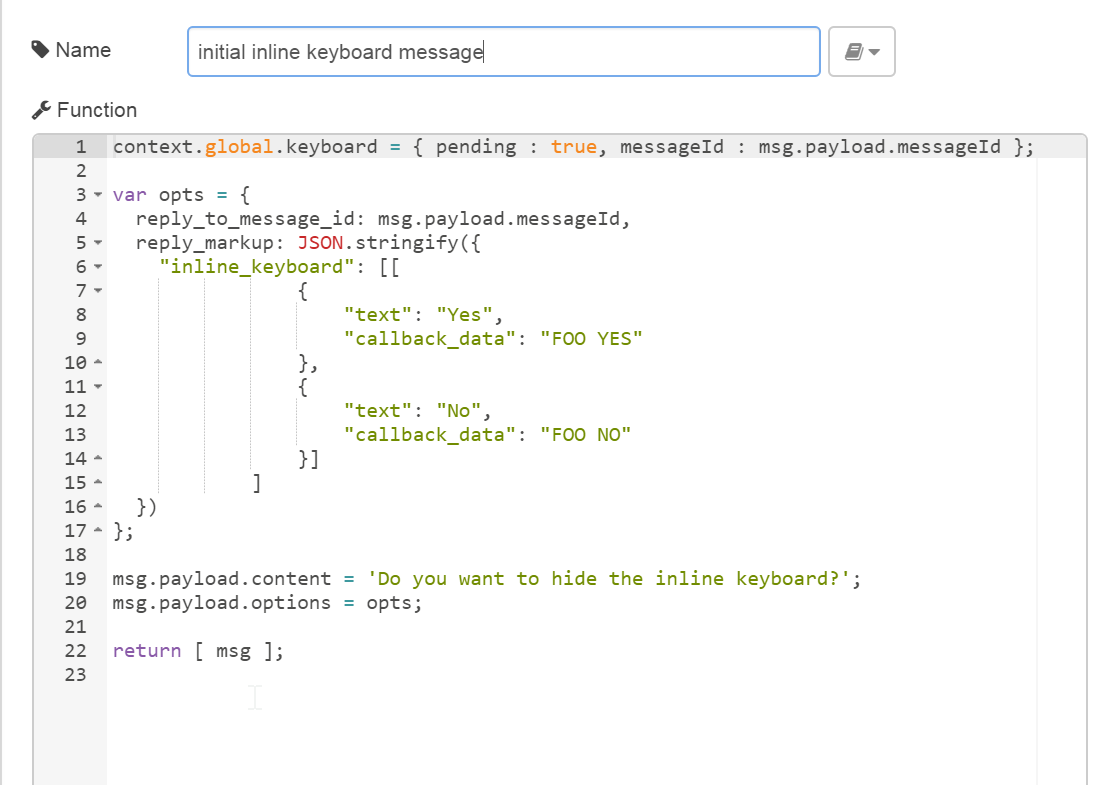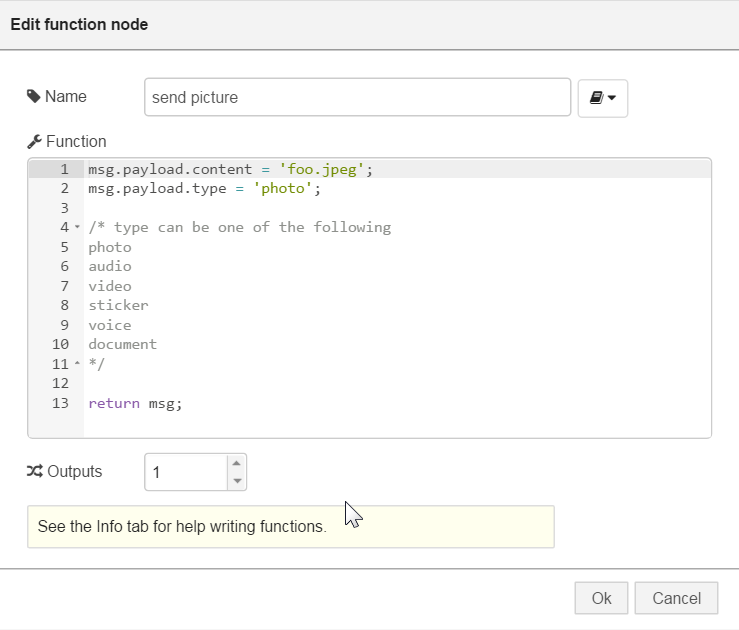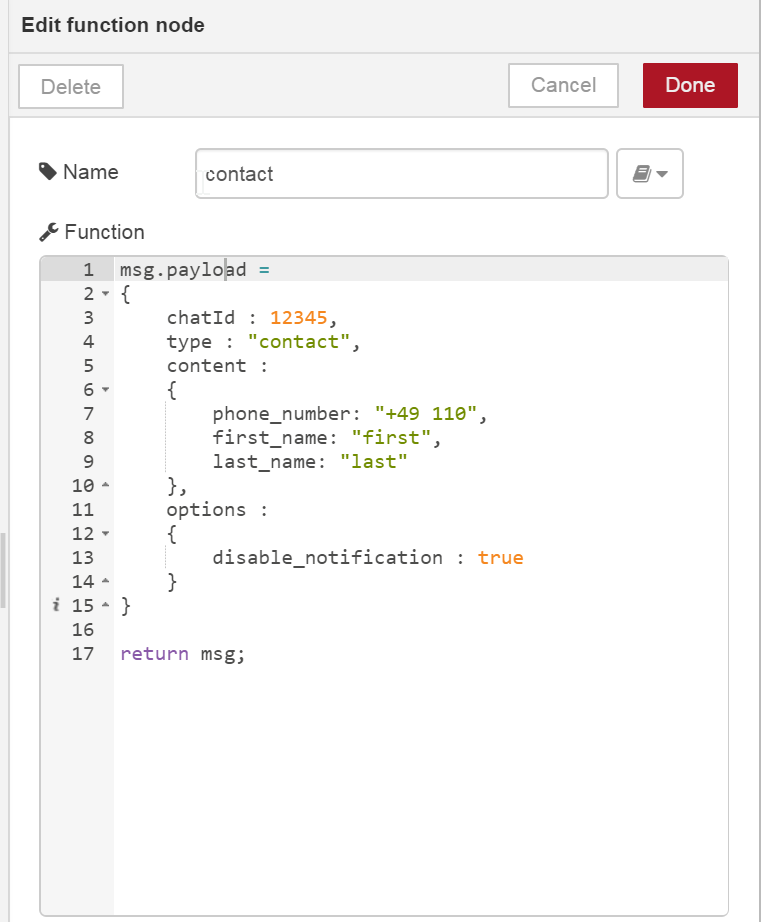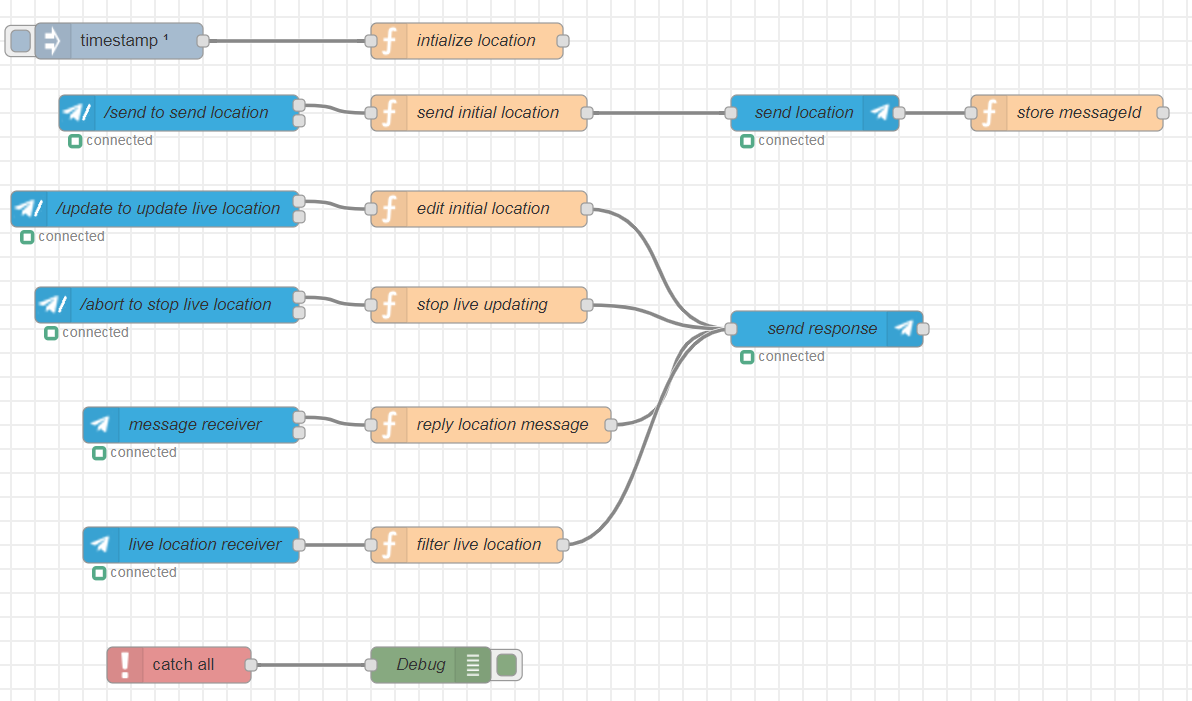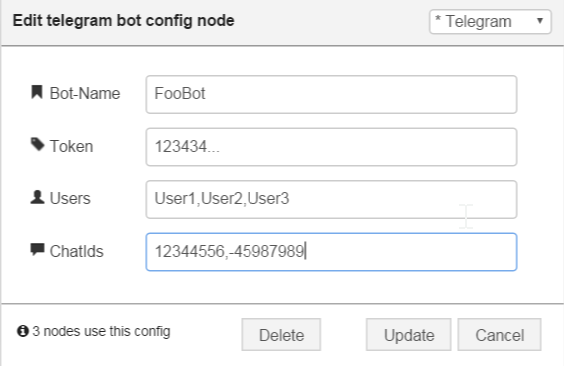Telegram bot nodes for node-red
This package contains a receiver and a sender node which act as a telegram bot. The only thing required is the token that can be retrieved by the @botfather telegram bot. https://core.telegram.org/bots
Thanks for your donation
If you want to support this free project. Any help is welcome. You can donate by clicking one of the following links:
Live support
Get help
If you have an urgent problem, hire a mentor for a 1:1 live session on Git-Start:
Provide help
Help others in paid 1:1 live sessions to get started.
Credits
dvv (Vladimir Dronnikov) for providing the saveDataDir configuration option. snippet-java for adding venue messages. And for providing the markdown problem fallback.
greenstone7 for providing the callback query node.
dceejay for cleaning up the project
psyntium for providing the weblink for additional content link videos, pictures, audio files.
MatthiasHunziker for extending the callback query node to support generic events
Skiepp for providing the send chat action idea.
MK-2001 for providing the sendMediaGroup function.
cowchimp for adding the support for node-red 1.x (async)
JokerQyou for adding the support for using webhook without certificate
Dependencies
The nodes are a simple wrapper around the node-telegram-bot-api It also depends on socks5-https-client
History
Version 4.x.x
Breaking changes: the former callback query node was replaced by the generic event node. You can replace the former callback query node in your existing flows with the event node. Please configure this event node to receive the callback query event.
Version 4.8.0
In this version the result returned by the sender node was changed for direct commands like for example editMessageLiveLocation, stopMessageLiveLocation, editMessageCaption, ... in a way that the msg.payload.content contains now the full object returned by the request instead of the msg.payload.sentMessageId property. All flows that did not make any use of those special functions should snot be affected.
Version 5.0.0
Finally webhooks are supported now. The configuration node was changed so that the required properties for webhook can be configured.
Version 5.2.1
This version contains SOCKS5 support: see https://github.com/windkh/node-red-contrib-telegrambot/issues/43
Version 5.3.0
Improved configuration node: grouped properties. Added support for custom and non custom certificates in webhook mode: see https://github.com/windkh/node-red-contrib-telegrambot/issues/66
Version 5.4.0
Added sendMediaGroup function: see https://github.com/windkh/node-red-contrib-telegrambot/pull/68
Version 5.5.0
Fixed restrictChatMember, kickChatMember, promoteChatMember, unbanChatMember functions: see https://github.com/windkh/node-red-contrib-telegrambot/issues/71
Version 6.0.0
Modified nodes to support node-red 1.x
Version 6.0.1
Removed warning when nodes register twice at the configuration node
Version 7.0.0
Updated https://www.npmjs.com/package/node-telegram-bot-api to version 0.40.0
Warning
The nodes are tested with nodejs 8.11.1 and node-red 0.20.3. This version shold support node-red 1.x and above but I did not really test it.
Usage
The input node receives messages from the bot and sends a message object with the following layout:
msg.payload contains the message details
- chatId : the unique id of the chat. This value needs to be passed to the out node when responding to the same chat.
- type : the type of message received: message, photo, audio, location, video, voice, contact
- content : received message content: string or file_id, or object with full data (location, contact)
msg.originalMessage contains the original message object from the underlying node-telegram-bot-api lib.
The output node sends the content to a specified chat. A simple echo flow looks like:
Configuration Node
The only thing to be entered here is the token which you received from @botfather when creating a new bot. The string is automatically trimmed. The node contains two optional properties: users and chatids. You may enter a list of names and/or chatids that are authorized to use this bot. This is useful, if the bot should only accept incoming calls from dedicated persons. The values in the property fields must be separated by a , e.g.: Hugo,Sepp,Egon Leave the fields blank if you do not want to use this feature. saveDataDir is an optional configuration value that can be set to automatically download all contents like music, video, documents, etc. The "Verbose Logging" flag should only be activated when debugging network problems as this will create cyclic warnings when the network is down.
By default the bot is polling every 300ms for new messages. But you can also make use of the webhook method to avoid polling. Before that you have to create your own certificate as described here: https://core.telegram.org/bots/webhooks https://stackoverflow.com/questions/42713926/what-is-easy-way-to-create-and-use-a-self-signed-certification-for-a-telegram-we One of many pitfalls when creating certificates (that don't work) is, that the value CN you provided to openssl must match the bots domain name: see "bot host" above.
Create our pair of private and public keys using the following command: Important: replace SERVER_NAME_OR_IP with the name you enter in the configuration node under "Webhook Bot Host". Both names must be equal, otherwise the telegram server won't send updates to your bot. You should also replace YOUR_NAME_OR_COMPANY_NAME with some value. Note that the certificate will expire after 365 days.
openssl req -newkey rsa:2048 -sha256 -nodes -keyout PRIVATE.key -x509 -days 365 -out PUBLIC.pem -subj "/C=NG/ST=Lagos/L=Lagos/O=YOUR_NAME_OR_COMPANY_NAME/CN=SERVER_NAME_OR_IP"
Webhook can also be used without certificate but then the bot host must be behind a tunnel see https://github.com/windkh/node-red-contrib-telegrambot/pull/93
SOCKS5 proxy support is optional when running behind a SOCKS5 proxy that requires authentication.
Receiver Node
This node receives all messages from a chat. Simply invite the bot to a chat. (You can control if the bot receives every message by calling /setprivacy @botfather.) The original message from the underlying node library is stored in msg.originalMessage. msg.payload contains the most important data like chatId, type and content. The content depends on the message type. E.g. if you receive a message then the content is a string. If you receive a location, then the content is an object containing latitude and longitude. The second output is triggered when security is applied and the user is not authorized to access the bot. See below.
When the receiver node receives data like videos, documents and so on, the file is downloaded automatically to the local harddisc when saveDataDir is set in the configuration node. The directory is also part of the message payload: msg.payload.path In addition to that the message contains the direct download link in the payload: msg.payload.weblink
The following types can be received (see type in output object):
- message - content is text
- photo - content is the file_id of the photo with the highest resolution (all photos are stored in the photos property of the output object)
- audio - content is the file_id of the audio file
- document - content is the file_id of the document
- sticker - content is the file_id of the sticker
- video - content is the file_id of the video file
- video_note - content is the file_id of the video note file
- voice - content is the file_id of the voice file
- location - content is an object with latitude and longitude
- venue - content is the venue object
- contact - content is the contact information object Note that media groups are received not as group, but as separate messages of type photo and video.
The following types indicate changes in the group or channel itself.
- new_chat_title - content is the new chat title
- new_chat_photo - content is the file_id (see photo)
- new_chat_members - content is an array of new chat members
- left_chat_member - content is an object describing the chat member that left
- delete_chat_photo - content is true
- pinned_message - content is the pinned message object
- channel_chat_created -
- group_chat_created -
- supergroup_chat_created -
- migrate_from_chat_id - content is the chat id. The chat property describes the chat.
- migrate_to_chat_id - content is the chat id. The chat property describes the chat.
Sender Node
This node sends the payload to the chat. The payload must contain the following fields: msg.payload.chatId - chatId msg.payload.type - e.g. "message" msg.payload.content - your message text msg.error - is set when an exception occurred
Next to sending content the sender node can be used to issue direct commands to the API. The msg.payload.type needs to be set to one of the following, the msg.payload.content contains the required arguments while additional arguments are passed in msg.payload.options (see examples for further details):
- editMessageCaption
- editMessageText
- editMessageReplyMarkup
- deleteMessage
- editMessageLiveLocation
- stopMessageLiveLocation
- callback_query
- inline_query
- action
- leaveChat
- kickChatMember
- unbanChatMember
- restrictChatMember
- promoteChatMember
- exportChatInviteLink
- setChatPhoto
- deleteChatPhoto
- setChatTitle
- setChatDescription
- pinChatMessage
- unpinChatMessage
- getChatAdministrators
- getChatMembersCount
- getChat
- getChatMember
Command Node
The command node can be used for triggering a message when a specified command is received: e.g. help. See example below. It has two outputs
- is triggered when the command is received
- is triggered when the command is not received
The second one is useful when you want to use a keyboard. See example below. Commands usually start with a / like for example /foo. According to the telegram api documentation the command should be issued following the bot name like /foo@YourBot. This is important when you add several different bots to one single group chat. To avoid that the bot handles commands that are not directly sent to it using the long notation you can set the "strict" mode in the options of the command node. In this case the bot only accepts the full command notation in group chats.
Event Node
The node receives events from the bot like:
- callback_query of inline keyboards. See example-flow inline keyboard flow in examples folder.
- inline_query
- edited_message which is triggered when someone alters an already sent message.
- edited_message_text which is triggered when someone alters an already sent message text.
- edited_message_caption which is triggered when someone alters an already sent caption e.g. of a photo.
- channel_post which is triggered when the bot is member of a public channel (/setprivacy to disabled!).
- edited_channel_post which is triggeren when someone alters an already sent message in a public channel.
- edited_channel_post_text which is triggeren when someone alters an already sent message text in a public channel.
- edited_channel_post_caption which is triggeren when someone alters an already sent caption of e.g. a photo in a public channel.
Reply Node
The reply node waits for an answer to a specified message. It should be used in conjunction with the sender node: See example below.
Implementing a simple echo
This example is self-explaining. The received message is returned to the sender.

Implementing a /help command
This flow returns the help message of your bot. It receives the command and creates a new message, which is returned:

Note: You can access the sender's data via the originalMessage property.
Implementing a keyboard
Keyboards are very useful for getting additional data from the sender.
When the command is received the first output is triggered and a dialog is opened:
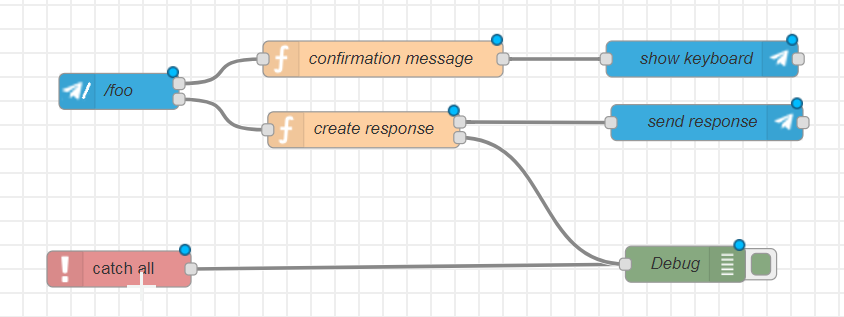 keyboard flow
keyboard flow
The answer is send to the second output triggering the lower flow. Data is passed via global properties here.
Implementing a on reply node
Next to the keyboard the bot could also ask a question and wait for the answer.
When the user responds to a specified message the telegram reply node can be used:
 onreplymessage flow
onreplymessage flow
The question is sent to the chat. This node triggers the on reply node waiting for the answer.
Note: that the user has to explicitly respond to this message. If the user only writes some text, the node will not be triggered.
 The last function shows how to evaluate the answer using a function node with two outputs.
The last function shows how to evaluate the answer using a function node with two outputs.
Implementing an inline keyboard
An inline keyboard contains buttons that can send a callback query back to the bot to trigger any kind of function.
When the command is received the first output is triggered and a inline keyboard is shown:
 inlinekeyboard flow
inlinekeyboard flow
The callback query is received by the event node. It must be answered like shown as follows: Here you can add your code to trigger the desired bot command. The answer contains the callback query data in msg.payload.content.
Edit an inline keyboard
An inline keyboard can be modified using the 'editMessageReplyMarkup' instruction. To be able to modify an existing message you need
to know the messageId of the message of the keyboard.
A sample flow is provided in the examples folder and could look like this:
 editinlinekeyboard flow
editinlinekeyboard flow
The message id needs to be saved in the flow or global context. This is just a demo assuming that there is only one single chat.

Replace the initial keyboard with a modified one using the magic 'editMessageReplyMarkup' command as type.
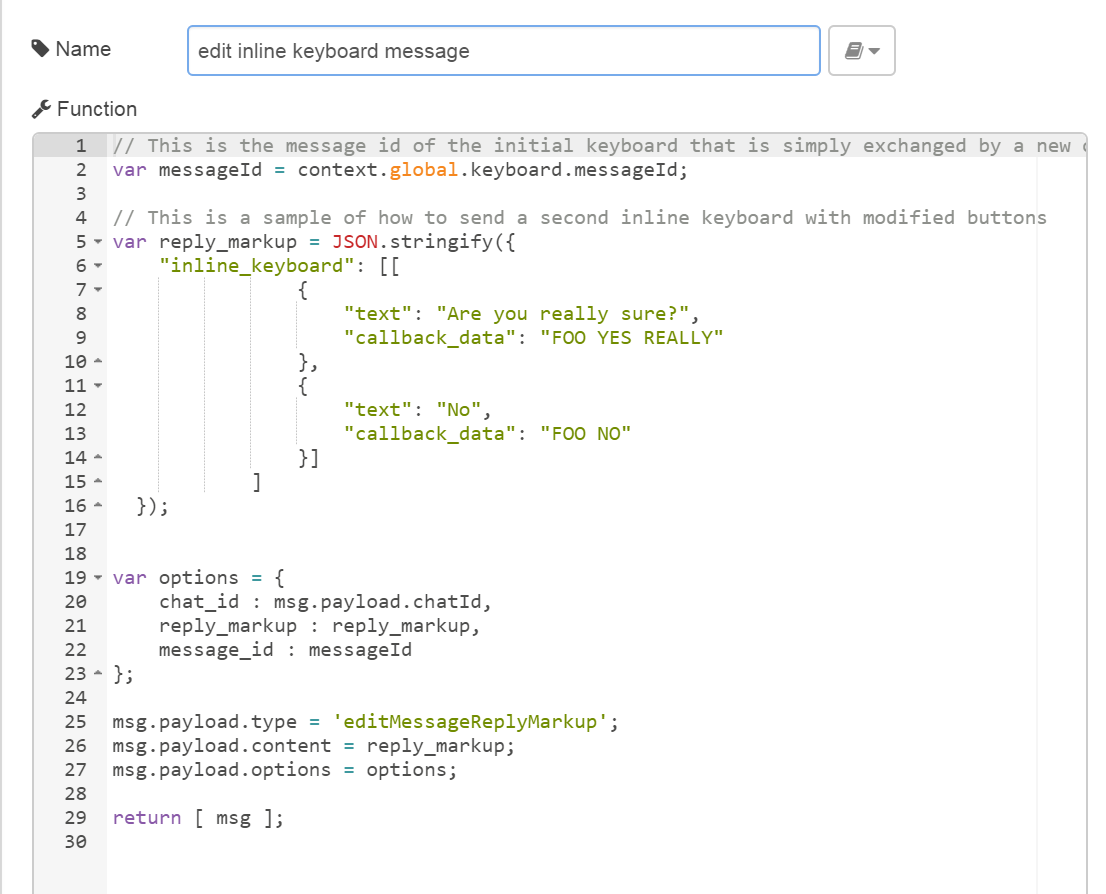
The following switch node just handles the response and hides the keyboard using another magic command: 'deleteMessage'

As an alternative to 'editMessageReplyMarkup' you can also use 'editMessageText' to replace the keyboard and also the text as follows:
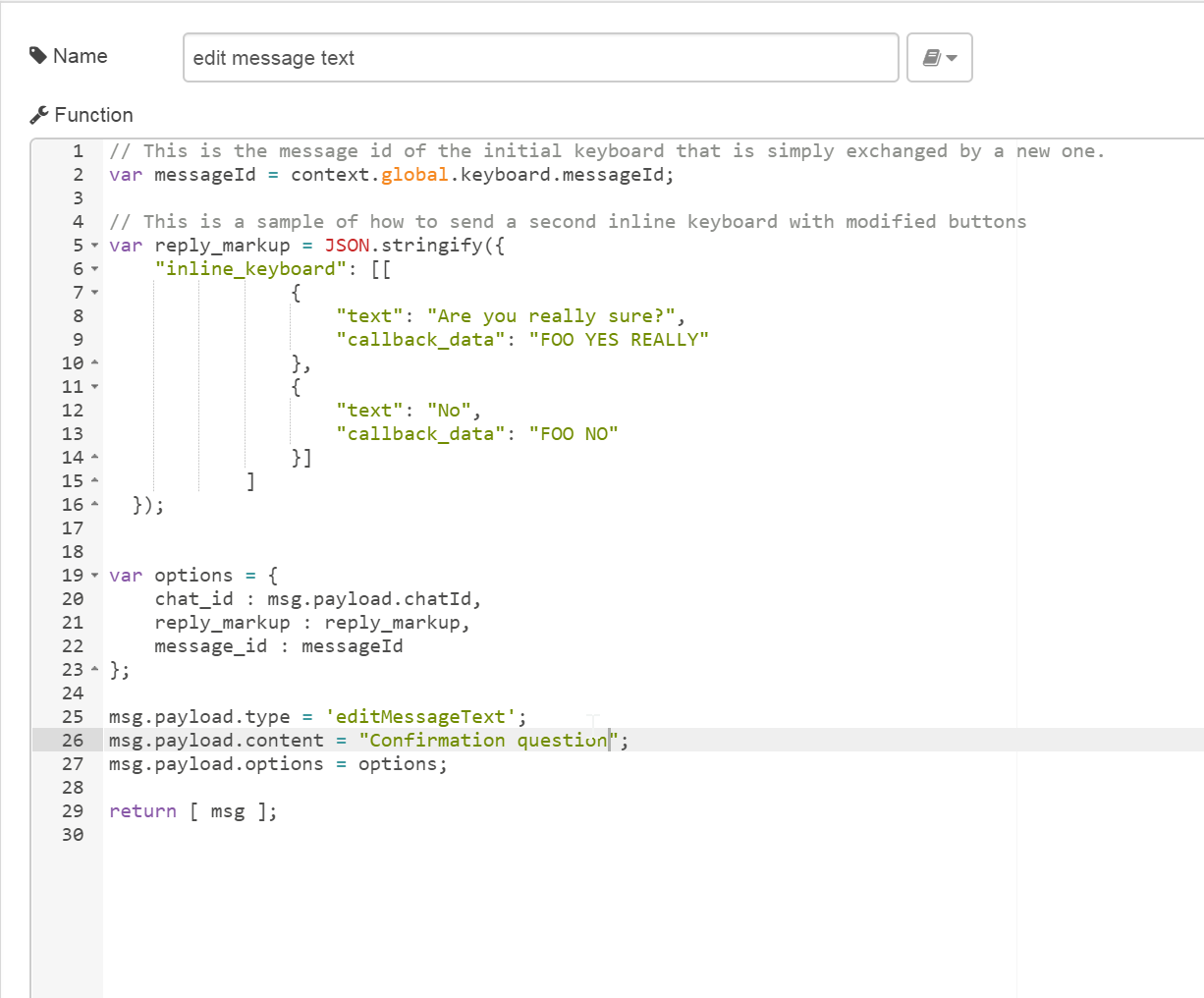
Implementing an inline_query
Bots can be called from any chat via inline_query when the bot is set to inline mode in botfather via /setinline
see https://core.telegram.org/bots/api#inline-mode
A sample flow is provided in the examples folder and could look like this:
 inlinequery flow
inlinequery flow
The inline_query must be answered by sending a results array.
see https://core.telegram.org/bots/api#inlinequeryresult
The example just returns two simple articles, but almost every kind of content can be returned.
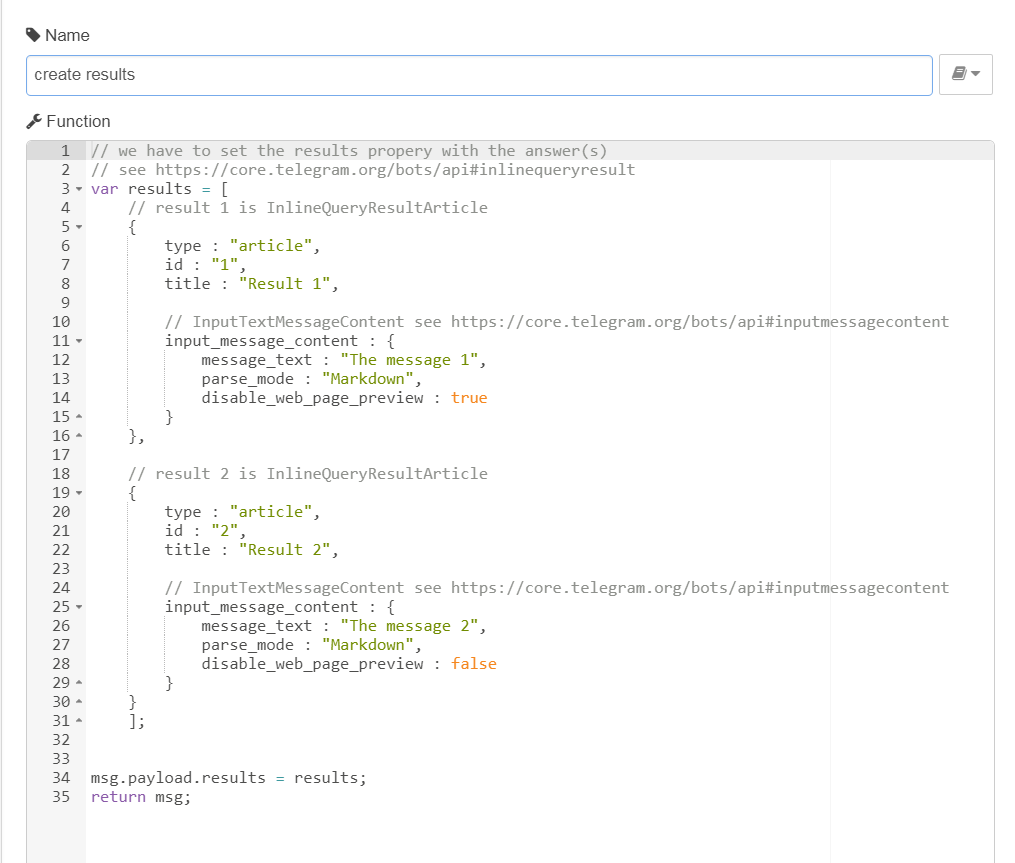
Note that the inline_query can also contain the location of the sender. To enable this call /setinlinegeo in botfather
Receiving a location
Locations can be send to the chat. The bot can receive the longitude and latitude:
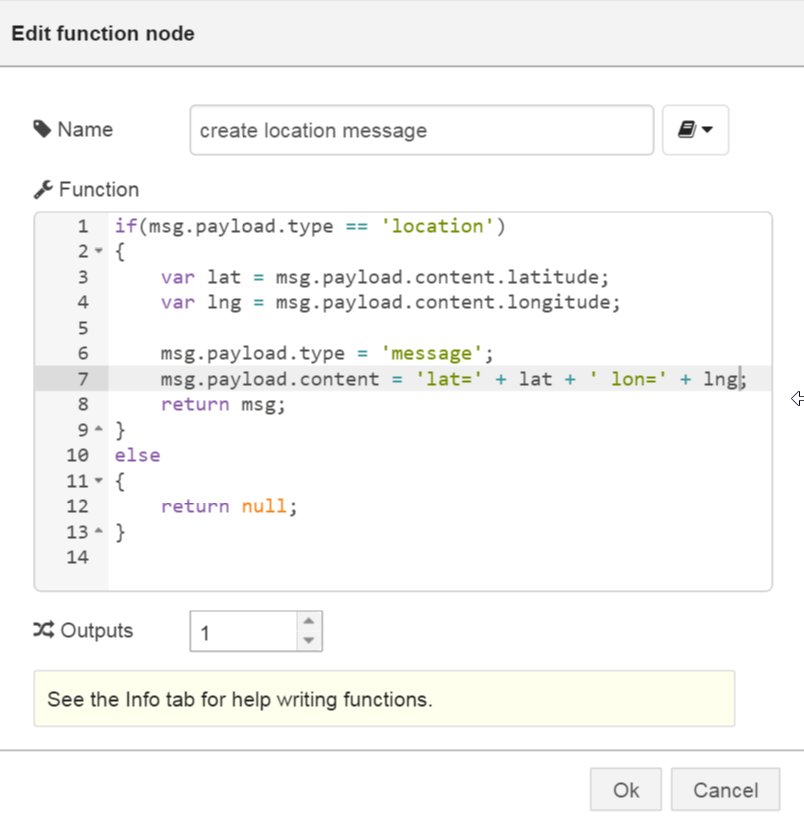
Sending messages to a specified chat
If you have the chatId, you can send any message without the need of having received something before.
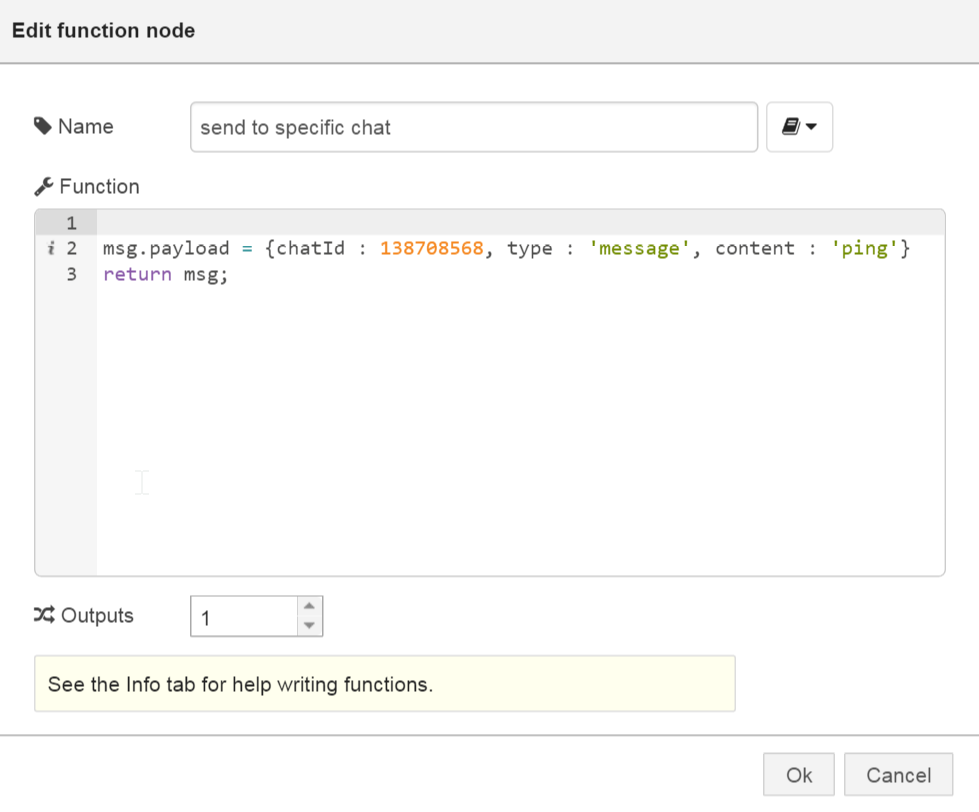 sendmessagetochat flow
sendmessagetochat flow
Sending photos, videos, ...
Next to sending text messages you can send almost any content like photos and videos. Set the right type and content and you are done. If you want to respond to a received message with a picture you could write:
msg.payload.content = 'foo.jpg';
msg.payload.type = 'photo';
Note: that the chatId is already the correct one when you reuse the received msg object from a receiver node.
You can use one of the following types to send your file as content:
- photo
- audio
- video
- video_note
- sticker
- voice
- document The content can be downloaded automatically to a local folder by setting the saveDataDir entry in the configuration node. You can add a caption to photo, audio, document, video, voice by setting the caption property as follows:
msg.payload.caption = "You must have a look at this!";
The following types require a special content format to be used. See the underlying node api for further details.
- location
- contact
- venue
- mediaGroup
Sending a mediaGroup as album
To send several photos as an album you can use the mediaGroup. For the type of media group you have to set the content to an array of object type InputMediaPhoto. Please review the Json below.
msg.payload = {
"chatId": 123456789,
"messageId": 1,
"type": "mediaGroup",
"content": [
{
"type": "photo",
"media": "/pic/frame_1.jpg"
},
{
"type": "photo",
"media": "/pic/frame_2.jpg"
},
{
"type": "photo",
"media": "/pic/frame_3.jpg"
},
{
"type": "photo",
"media": "/pic/frame_4.jpg"
}
]
}
Sending contact
Sending a contact is limited to the fields supported by the underlying API to "phone_number" and "first_name". But you can also receive "last_name" if the client sends it.
msg.payload.type = 'contact';
msg.payload.content : { phone_number: "+49 110", first_name: "Polizei" };
Sending chat actions
When the bot needs some time for further processing but you want to give a hint to the user what is going on, then you can send a chat action which will appear at the top of the channel of the receiver.
msg.payload.type = 'action';
msg.payload.content = "typing";
The content can be one of the following
- "typing" for text messages
- "upload_photo" for photos
- "record_video" or "upload_video" for videos
- "record_audio" or "upload_audio" for audio files
- "upload_document" for general files
- "find_location" for location data
- "record_video_note" or "upload_video_note" for video notes
The following example illustrate how to send for example "typing...". Of course a real bot would send the real data after finishing the processing, but this is not part of the example. sendchataction flow
Sending live locations
Locations can be send to the chat as described above and then updated afterwards: live location update. To achieve this you have to provide the live_period in seconds in the options when sending the location.
msg.payload.type = 'location';
msg.payload.content = {
latitude : lat,
longitude : lng
};
msg.payload.options = {
live_period : time
};
To be able to update this location message you need to store the message id of that sent message. This can be done by storing it somewhere in the flow context as follows:
var messageId = msg.payload.sentMessageId;
flow.set("messageId", messageId);
Now you can edit the location as often as you want within the live_period:
var messageId = flow.get("messageId");
var chatId = msg.payload.chatId;
msg.payload.type = 'editMessageLiveLocation';
msg.payload.content = {
latitude : lat,
longitude : lng
};
msg.payload.options = {
chat_id : chatId,
message_id : messageId
};
If you want to abort updating the location then you can send the stopMessageLiveLocation command.
var messageId = flow.get("messageId");
var chatId = msg.payload.chatId;
msg.payload.type = 'stopMessageLiveLocation';
msg.payload.options = {
chat_id : chatId,
message_id : messageId
};
Receiving live location updates
When a user sends his location then it is received by the standard message receiver node. But when a live location is updated, then you will receive the same message event as one would edit an already existing message in the chat (edit_message). The example above contains an event handler node that receives those message edits, and filters for the ones that contain a location.
Advanced options when sending messages.
Text messages can be in markdown format to support fat and italic style. To enable markdown format set the parse_mode options property as follows:
msg.payload.options = {parse_mode : "Markdown"};
Telegram always adds a preview when you send a web link. To suppress this behavior you can disable the preview by setting the options property as follows:
msg.payload.options = {disable_web_page_preview : true};
The callback query answer has a show_alert option to control the visibility of the answer on the client. It is directly mapped to the options property.
msg.payload.options = true;
Configuring security
The configuration node contains two properties for applying security to your bot. You can choose between configuring the single usernames or configure one or more chat-ids that are allowed to access the bot. The values must be separated using a comma like shown in the screenshot.
Note: that the chat-ids are positive in chats where you talk to the bot in an 1:1 manner. A negative chat-id indicates a group-chat. Everybody in this group is allowed to use the bot if you enter the chat-id of the group into the lower field of the configuration node.
Detecting unauthorized access.
The receiver node has a second output, that is triggered when authorization fails. The message is send to this output for further processing.
You can reply on that message or log it to a file to see who wanted to access your bot.

The message needs to be formatted before the log to file node can be triggered. A simple function could look like this:
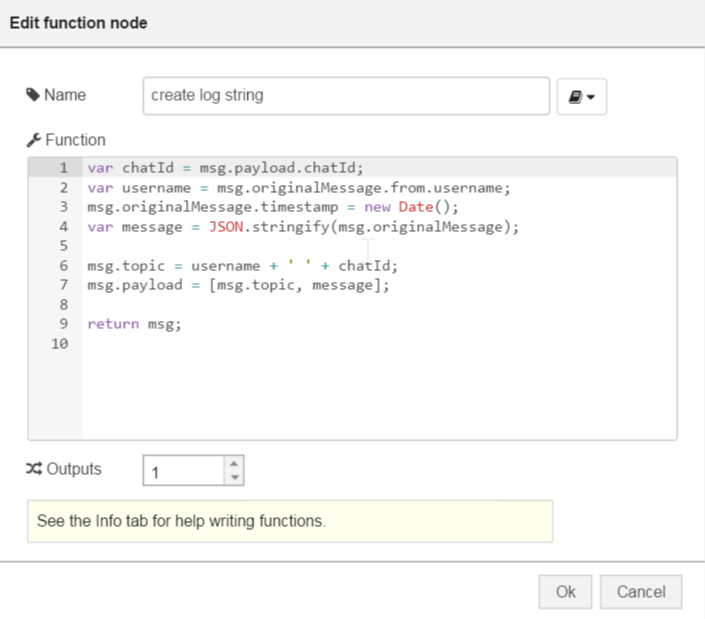 unauthorizedaccess flow
unauthorizedaccess flow
Implementing a simple bot
Putting all pieces together you will have a simple bot implementing some useful functions.
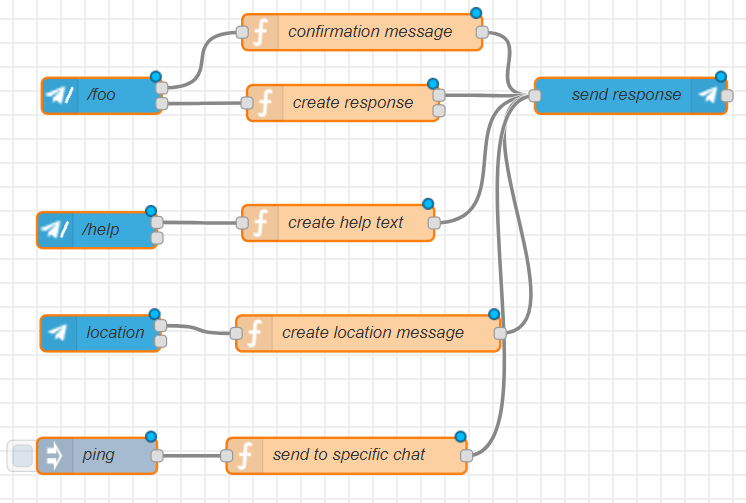 simplebot flow
simplebot flow
All example flows can be found in the examples folder of this package.
License
Author: Karl-Heinz Wind
The MIT License (MIT) Copyright (c)
Permission is hereby granted, free of charge, to any person obtaining a copy of this software and associated documentation files (the "Software"), to deal in the Software without restriction, including without limitation the rights to use, copy, modify, merge, publish, distribute, sublicense, and/or sell copies of the Software, and to permit persons to whom the Software is furnished to do so, subject to the following conditions:
The above copyright notice and this permission notice shall be included in all copies or substantial portions of the Software.
THE SOFTWARE IS PROVIDED "AS IS", WITHOUT WARRANTY OF ANY KIND, EXPRESS OR IMPLIED, INCLUDING BUT NOT LIMITED TO THE WARRANTIES OF MERCHANTABILITY, FITNESS FOR A PARTICULAR PURPOSE AND NON-INFRINGEMENT. IN NO EVENT SHALL THE AUTHORS OR COPYRIGHT HOLDERS BE LIABLE FOR ANY CLAIM, DAMAGES OR OTHER LIABILITY, WHETHER IN AN ACTION OF CONTRACT, TORT OR OTHERWISE, ARISING FROM, OUT OF OR IN CONNECTION WITH THE SOFTWARE OR THE USE OR OTHER DEALINGS IN THE SOFTWARE.






